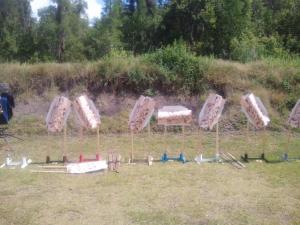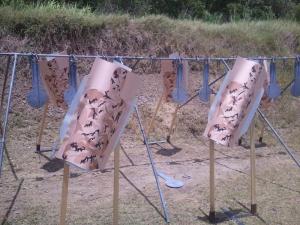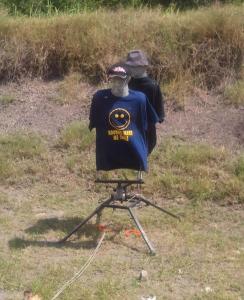I just got back from taking Louis Awerbuck’s Tactical Shotgun I class. My only previous experience with the Shotgun is Randy Cain’s Shotgun I class (see my write up here) about two years ago, and a few trap shooting outings with friends.
For those of you who are unfamiliar with Louis Awerbuck, he served in the South African Defence Force and has been training firearms for over thirty years. Randy considers him the best in the business, so naturally, I came into this class with big expectations.
Day 1
 The course started out with a three hour briefing on safety, range etiquette, and all manner of information about the shotgun, everything from desirable features on a shotgun, idiosyncrasies of various models of shotgun, and ammunition selection to the mechanics of loading and unloading the weapon and the most common reasons for malfunctions. Before the briefing, Louis warned us that he talks more than anyone in the business and shoots less.
The course started out with a three hour briefing on safety, range etiquette, and all manner of information about the shotgun, everything from desirable features on a shotgun, idiosyncrasies of various models of shotgun, and ammunition selection to the mechanics of loading and unloading the weapon and the most common reasons for malfunctions. Before the briefing, Louis warned us that he talks more than anyone in the business and shoots less.
Louis is a bit of a character with a wry sense of humor and self deprecatingly refers to his “magnetic personality.” He is soft spoken and despite repeated admonitions of how much a jerk he is, we never witnessed it during our three days. His style is very low key, and he is very patient helping students to improve.
After lunch, we headed out to the range to pattern the shotguns with buckshot. I was using some really cheap buckshot that had an enormous pattern. After the second shot at seven yards, my pattern was about seven inches across. Other targets were had two inch patterns. He used my target to show just how much ammunition selection can affect the pattern. A second shot at seven yards with Federal Tactical 00 buck showed a 3 inch group, “Fastest barrel job you’ve ever seen. I just saved you several hundred dollars.”
After patterning the guns, we moved over to steel targets and ran a variety of drills including the ever popular Rolling Thunder.
Day 2
We started with some warm up drills on the steel and then did several variations of Rolling Thunder that involved a very small amount of teamwork and communication. Then we zeroed the shotguns on paper at 25 yards. Somewhere during this time, the class started dragging because people weren’t listening or paying attention. At this point, Louis really let the class have it, “Gentleman, I can’t run an unsafe range.”
After lunch, whatever had infected the group seemed to be gone, and we did a variety of slug drills and select slug before getting rained out.
Day 3
 Again, we started with shot on the steel, only this time, it was complicated by having paper targets in front of and behind the steel. We were not allowed to hit the paper targets, forcing us to think about foreground and background, the size of our pattern, and how changing angles changes the target availability. Louis stressed that often, the best choice is not to take the shot.
Again, we started with shot on the steel, only this time, it was complicated by having paper targets in front of and behind the steel. We were not allowed to hit the paper targets, forcing us to think about foreground and background, the size of our pattern, and how changing angles changes the target availability. Louis stressed that often, the best choice is not to take the shot.
Then we moved to Louis’ special moving rig target. We had to shoot an erratically moving bad guy with a bystander just behind him. Then we repeated the drill with a partner and three innocent bystanders.
Then we set aside the shotguns for handguns. Louis had set up targets at various angles to stress that the position of the target changes what constitutes a good hit. Four inches low on an upright straight on torso might still be a good hit. Four inches low on a torso at 45 degrees might be a miss altogether. Moreover, the targets were bowed outward to simulate a three dimensional person, stressing that the breastbone isn’t always center mass. This drill also had a second purpose. If we could not shoot handgun groups tight enough, we would not be allowed to actually fire the handguns on the next drill—handgun transitions.
 First we learned how to dump the shotgun safely in order to draw the handgun. Then we went through the transition drills without shooting, then again with shooting. As a team, we had to hit every steel plate with buckshot from ten yards without hitting paper, then transition to handgun and hit every paper target without hitting any steel. Then we repeated the drill with select slug instead of transitioning to handgun.
First we learned how to dump the shotgun safely in order to draw the handgun. Then we went through the transition drills without shooting, then again with shooting. As a team, we had to hit every steel plate with buckshot from ten yards without hitting paper, then transition to handgun and hit every paper target without hitting any steel. Then we repeated the drill with select slug instead of transitioning to handgun.
Finally, we did long distance slug shooting at 50 and 75 yards on a steel target.
Conclusion
If I had to sum up the class in two words, it would be “Rule Four”. Being sure of your target was really the focus of the whole class. Louis’ class is very cerebral, with a lot of judgment calls about angles and thinking about what’s behind the target. Know your shotgun’s pattern at this distance and know whether you can safely make the shot.
The class had a relatively low round count, around 200 shot, and maybe 30 slugs. I don’t think I would recommend it for someone’s first shotgun class, not because of the low round count, but because the barrage of information can be overwhelming if you are completely unfamiliar with the shotgun and its concepts. Also Louis sometimes would say, “here’s the right way to do it” and then expected us to be able to do it without much practice. I think Randy’s class would be a better choice for a complete shotgun newbie because you just get more repetitions, and Randy goes slower on the initial skills. (On the other hand the lower round count is much easier on the shoulder). Either way, I do not think any shotgun student could call their education complete without taking Louis Awerbuck’s class. Randy Cain says that Louis Awerbuck is the best in the business, and I can understand why.
Thoughts about shotgun selection
Randy Cain is very clear that he prefers the Remington 870, and everything else is inferior. Louis Awerbuck seems much more appreciative of other shotguns, although most of the problems in our class stemmed from the autoloaders (as Randy predicted). The few Remington 870 issues we had stemmed from aftermarket parts. I set my 870 up according to Randy’s recommendations, and it ran like a champ. I had no problems. One thing I learned from listening to Louis’ comments to other students is that the Mossberg’s main advantage is its safety. (It’s on top, so you can turn it on or off without breaking a firing grip (including lefties).) However, if you put a pistol grip on a Mossberg, then it completely negates that advantage, because you can’t access the safety unless you break the firing grip.
Thoughts about the range
This is the fourth class I have taken at Southern Exposure Training. I can see a definite pattern. The classes are a mixture of law enforcement/law enforcement, security personnel, and regular folks with a large amount of repeat customers. Most have trained at other facilities and with other instructors, but keep coming back to Southern Exposure because of the high quality of instructors that Irv Lehman brings in combined with the relaxed but professional atmosphere. In every class that I have taken, at least one student has traveled from out of state to train there. I will be definitely be back.

Recent Comments